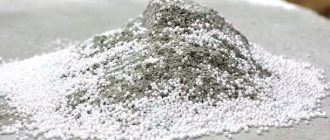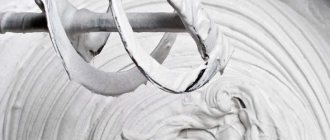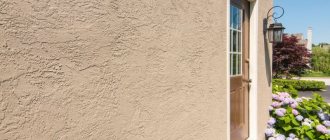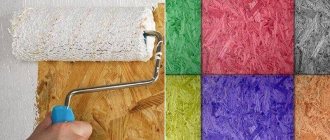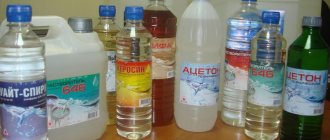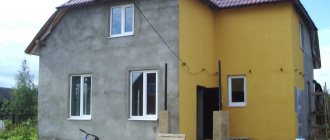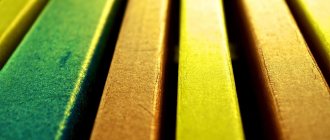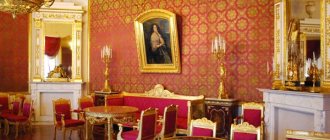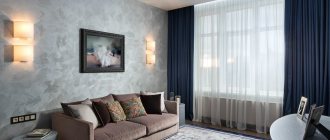Decorative plasters give rooms a unique look.
They not only level the walls, but also create a finishing coating that does not require further finishing.
A variety of decorative mixtures can bring to life any design solutions for the decoration of buildings. It is possible to imitate granite or marble, silk or metal.
Doing decorative plaster with your own hands is a great way to express your creative abilities, bring to life any design solutions, create unique unique scenes, and stand out from the general background.
Figure 1. Decorative plaster in the interior.
What is decorative plaster
Decorative plaster is a coating with a certain artistic effect.
It comes in two types:
- Textured, the design of which is created by a master.
- The structural, decorative layer is formed by various additives: stone chips, fibers, granules.
Decorative plaster is used to decorate the facades of buildings and to decorate interior spaces.
Exterior finishing, in addition to being decorative, also performs protective functions: it protects facades from atmospheric influences, dirt and dust.
Interior decorative plaster can be uniform, relief or textured.
Figure 2. Methods of applying decorative plasters.
Decorative compositions can be applied with spatulas or special attachments mounted on rollers.
The type of coating is influenced by the components included in the mortar mixture, the tools used and the methods of applying the plaster.
The color of the decorative finish can be easily changed by applying paint to relief coatings with a brush or sponge, and to smooth, uniform surfaces with a spray gun or roller.
TOP 3 best products according to customers
Decorative plaster Unis / Eunice “Bark beetle-Decor” 2.0 mm 25 kg
400.00 rub.
Product code 12668
Eunice Bark Beetle Decor is a textured decorative plaster based on white cement with added.....
Decorative plaster Unis / Eunice “Bark beetle-Decor” 3.0 mm 25 kg
400.00 rub.
Product code 12669
Decorative plaster Unis / Eunice “Bark beetle-Decor” 3.0 mm 25 kg Decorative coarse.....
Gypsum plaster Standard 30 kg
200.00 rub.
Product code 12332
Gypsum plaster Etalon 30 kg The main characteristics of Etalon plaster is the presence in .....
Manufacturers of decorative plaster mixtures and estimated product prices
There are not many manufacturers of decorative plaster mixtures in the world who guarantee the high quality of their finishing compositions. Most often on the shelves of construction stores you can find products from the following brands: Knauf, Ceresit, Vetonit, BauMit, Caparol and Weber.
The cost of mineral decorative plaster mixtures, depending on the region of sale and manufacturer, can range from 8 to 12 USD. for a 25 kg bag of powder. The average consumption of such plaster is in the range of 2.5 – 4 kg per 1 m2.
The price of silicate composition for decorative wall finishing starts from 14 and ends at 40 USD. for a standard 25 kg bag. The consumption of such mixtures ranges from 1.5 to 4 kg per 1 m2. Moreover, it strongly depends on the size of the filler granules. The price of acrylic plaster ranges from 15 – 38 USD/25 kg at a consumption of 1.5 – 3.5 kg/m2. Silicate mixtures cost 30 to 70 USD per 1 m2, and their consumption is 2.5 - 3.9 kg per 1 m2 of surface to be finished.
Tools, devices
The following tools are used to create decorative plasters:
- a drill with an attachment or a construction mixer for mixing the solution;
- spatulas of various widths for applying finishes;
- trowel or trowel for throwing mortar;
- various brushes, sponges, meshes and other devices for creating designs;
- rollers with special attachments for creating patterns and reliefs;
- wooden, metal and plastic graters for grouting and creating textured coatings;
- various templates with patterns;
- cutters for cutting out ornaments and designs.
Figure 3. Tools used for decorative plaster.
I recommend!
To create decorative plasters with your own hands, you can use the most unexpected objects: combs, sponges, brushes, crumpled paper or cellophane. Even with ordinary gloves you can create original textures.
Textured plasters
In this case, we are talking about a material that contains fine-grained fillers, so after drying a smooth surface is formed. The plaster received this name due to the fact that before setting, various relief patterns are applied to the surface using floats, half-graters, trowels, figured spatulas, brushes and rollers. The advantage of textured plasters over structural ones is that the master has the opportunity to implement his own design solutions. At the same time, structural materials are easier and faster to apply.
VIDEO:
Cooking recipes
For wet rooms and outdoor work, cement-based material is used. To a standard bag of cement (weight 50 kg) add 10 kg of ordinary tile adhesive. After this, 0.5 kg of Rotband plasticizer is added to the mixture. Lastly, add water and mix the mixture thoroughly.
For finishing surfaces inside dry rooms, the gypsum option is better suited. To do this, you will need 6 kg of dry ready-made plaster mixture based on gypsum, 200 g of PVA glue and 2 liters of water. The process of making textured plaster with your own hands is somewhat complicated and includes the following steps:
- First of all, 1.5 liters of water are poured into the dry mixture and mixed thoroughly until a homogeneous mass is formed.
- Then PVA glue is added to the remaining water and mixed as well.
- At the end, you need to make a homogeneous mass from the two mixtures, its consistency should resemble thick sour cream.
Self-preparation of a solution from gypsum plaster, PVA glue and water.
Also, do-it-yourself decorative plaster is made on the basis of white Portland cement of a grade of at least 400. The most popular recipes for making 1 kg of such mixtures:
- 200 g of lime dough are mixed with 740 g of marble flour and 50 g of cement, at the end 10 g of manganese peroxide and a little water are added.
- 630 g of white sand, 150 g of crushed brick, 50 g of cement and 150 g of lime dough are mixed and 20 g of water are added.
- 180 g of marble flour, 600 g of lime sand, 80 g of cement and 120 g of lime dough are mixed and 20 g of water are added.
You should know! If liquid plasticizers are used, their mass fraction should not exceed 1% of the total weight of the solution. Dry ones are added at the rate of 0.5 kg per 50 kg of cement.
Mixtures for decorative plasters
Compositions for decorative plasters are produced in the form of dry mixtures or solutions, completely ready for use. Dry mixtures are supplied in bags, and ready-made mixtures are supplied in sealed plastic containers.
Figure 4. Ready-made decorative plasters.
Solutions must retain plasticity for a certain time in order to create textured patterns and form relief surfaces, providing high strength when solidified.
The fillers in the solution can be:
- marble and granite dust or crumbs;
- synthetic granules;
- quartz sand;
- coloring pigments;
- synthetic or natural fibers.
Figure 5. Fillers for decorative plaster.
The binding components can be cement, lime, natural or synthetic resins.
In addition, the solutions contain plasticizing or hydrophobic additives.
Ready-made paste solutions are more expensive than dry mixtures, but they are completely ready for use and easier to use. In addition, such compositions can be stored for a long time in a closed container.
Classification of decorative plaster by type of binder
- Lime is used as a natural binder. It serves as the basis for mineral plaster. The latter is characterized by high vapor permeability and excellent resistance to sunlight. Fillers are also usually mineral pigments and substances. The strength characteristics of the material only improve over time. However, its plasticity is low, so this mixture is sold only in structural coatings.
The group of materials based on synthetic resins is divided into three main categories.
- A mixture based on acrylic resin - allows the use of a variety of fillers, provides a long period of plasticity. The coating is characterized by good moisture resistance, durability, resistance to temperature and decorativeness. Disadvantage: low vapor permeability.
- Silicone resin as a binder imparts vapor permeability, moisture resistance, insensitivity to ultraviolet radiation and chemical inertness to the finish. The disadvantage is the rather high cost of the material.
- Silicate compounds provide good vapor permeability and resistance to weather conditions. The silicone-based coating is not at all afraid of water and is easy to clean. The disadvantage is the small selection of colors, which, however, is easily solved through the use of tinting, pastes and colored wax.
Solid components
This category includes any ingredients of another fraction: stone flour or crumbs, plant fibers, solid synthetic particles, and so on. Their decorative properties depend on the color, brightness and particle size. The latter is important when calculating the mixture.
- Coarse aggregate - stone chips, particles of colored and ordinary glass, porcelain, anthracite, etc. The grain size is over 2.5 mm. The density of the resulting mixture should not exceed 1700 kg/cubic meter. m.
- Medium filler - particle size ranges from 0.6 to 2.5 mm. This is quartz sand of various fractions.
- Fine – stone flour – marble, malachite, quartz, and pigments. The grain size must be less than 0.6 mm. This filler is most often used in the manufacture of Venetian plaster.
The amount of filler depends on the size of the cement. Therefore, in the mixture the total proportion of solid components should be 20, 30, 40 and 50% relative to the weight of cement of the corresponding brand - 300, 400, 500, 600.
Making your own solutions
The building mixtures and solutions offered on the construction market are quite expensive.
To save money, it’s easy to prepare decorative mixtures with your own hands using the following recipes:
1. Decorative mixture based on putty
As the main component we take ordinary putty. We add fine quartz sand or marble dust for smooth plasters, stone chips for embossed plasters, such as bark beetles.
To add color, add dyes.
I recommend!
Add gold, silver or bronze powder to give a noble metallic shine and unusual shimmer.
To improve the ductility, strength and reliability of the coating, we add PVA glue, deep penetration primer and hydrophobic additives.
Mix the mixture thoroughly using a mixer or drill with a special attachment.
2. Mixture based on PVA glue
We take a ten percent solution of laundry soap, diluted to the consistency of a thick gel, 800 grams of PVA glue and a five percent solution of CMC wallpaper glue, from two kilograms of dry powder.
Add 6.5 kilograms of chalk powder, gypsum or calcium carbonate to the resulting mixture, stirring vigorously using a drill with an attachment.
Mix the composition until smooth and plastic.
3. Mixture based on tile adhesive
This composition is ideal for wet areas. The dry adhesive mixture is diluted according to the instructions on the package and applied to the coating in a thin layer. The desired texture is created using a sponge, rollers with attachments, and a paint brush.
4. Mixture based on gypsum binders
Applicable only for interior decoration. It is prepared from well-washed river sand, dry gypsum putty or atengypsum, mineral additives, dry gypsum mixture and polymers.
The dry ingredients are mixed with clean water and mixed to a paste-like consistency.
5. A mixture based on cement, marble flour and crumbs
Mortar for plaster imitating natural stone. It is made from cement, lime paste, marble flour and crumbs, with the addition of mica in proportions 1:0.5:0.5:3:0.5.
To obtain an imitation of yellow marble, ocher is added to the composition, for gray granite - manganese peroxide, for red granite - red lead.
Mineral decorative plaster and its features
Such plaster mixtures are made based on mineral substances such as cement, gypsum or lime. It is sold in a dry powder state and before finishing work begins, it is mixed with water in the required proportion, which is written on the packaging. This decorative plaster mixture is usually used when it is necessary to finish brick, plasterboard or concrete bases. Before applying the finished solution, the surface is treated with a primer that contains quartz sand.
Mineral plasters have high strength, moisture resistance and vapor permeability. They all have the same basic white color, so they require a tinting process before use. To enhance the decorative qualities, sparkles and marble chips are added to mineral plaster mixtures. This type of decorative finishing is suitable for interiors and building facades. The main disadvantage of mineral compositions is considered to be low plasticity, which leads over time to the inevitable formation of microcracks.
Advantages and disadvantages of decorative plaster
Decorative plaster has gained great popularity due to its high aesthetic, technical and operational qualities:
- environmental cleanliness and safety;
- strength and durability;
- resistance to mechanical stress;
- versatility, suitable for finishing structures made of any materials indoors and outdoors;
- weather resistance.
Decorative plaster has taken its rightful place in the construction market and has become an alternative to wallpaper, tiles and painting.
The main disadvantage of most decorative plasters is the high cost and complexity of application, which requires high skill.
I recommend!
Finish the wall in one day, otherwise unsightly joints will form that cannot be eliminated.
Topic: DECORATIVE FINISHING SOLUTIONS
Purpose : to study the main types and purposes of decorative and finishing mortars, as well as methods for studying the main physical and mechanical parameters.
Materials and equipment: technical scales with measurement accuracy up to 1g, spherical cup and blade, mortar mixer, standard cone, hydraulic press, metal ruler.
To give buildings and structures an aesthetic appearance in the construction industry, the following types of solutions are used:
mortars based on cement, lime-gypsum, lime, slag-cement and other types of binders;
decorative solutions;
glue solution
Construction mortars are intended for plastering, masonry and special (anti-corrosion, insulating) work. In the solution, a mixture of water and binder envelops the aggregate grains, making the mixture mobile and convenient for work.
To obtain decorative mortars, mainly white and colored cements are used. In some cases, decorative solutions based on lime and gypsum are used, the production of which is based on mixing them with pigments in a ball mill during grinding. Decorative plaster coatings are divided into two groups:
enriched - for finishing large surfaces and are made in the form of colored, stone-like and stone-like plaster;
ornamental - for finishing small surfaces, such as a panel frieze.
colored textured plasters are prepared on the basis of colored sand mortar, which is enriched not only with color, but also with texture. To give color to the solution, the following pigments are introduced: mummy, red lead, chromium oxide, ocher, etc. Stone-like and stone-like plaster is obtained by adding finely crushed rocks of decorative properties to the composition of the components: marble, granite, sandstone, labradorite, etc. Mosaic plaster is prepared on the basis binder, fine aggregate and pieces of various shapes and sizes of colored ceramic shards or smalt.
Colored decorative solutions imitate natural stone cladding and provide original color schemes for building facades. The main types of decorative plasters for exterior and interior decoration of buildings, as well as the front surfaces of panels, are lime-sand, terrazite, stone and sgraffito. They are usually done in two or three layers. The first layer levels the surface (ordinary plaster), the second is the primer and serves as the basis for the third, a decorative layer. Decorative plasters must meet artistic, aesthetic, technical and operational requirements. The composition of the decorative mortar is selected experimentally using test cards measuring 50x50cm, changing the ratio of the components. Polymer-cement decorative mortars are obtained by adding a polymer additive (0.05...0.2% by weight of the binder) to the solution, which only plasticizes or hydrophobizes the solution. 3...5% polymer additive slows down the hardening of cement. Most often, aqueous dispersions of water-insoluble polymers are used: polyvinyl acetate dispersion (PVA) and synthetic rubber latexes (SR). 10...20% of the polymer by weight of cement can be added to the dispersion solution. Stabilizers, such as surfactants and liquid glass, are used to prevent coagulation of the dispersion in solution. Polymer-cement mortars are very plastic and easy to install; with a lower water content, they have increased frost resistance, water resistance, water resistance, weather resistance and increased adhesive ability.
Depending on the ratio between the amount of binder and filler, mortar mixtures are fatty, with an excess amount of binder, normal, and lean, characterized by a small amount of binder, low plasticity and mobility.
The fat content of the mortar mixture is determined by immersing an oar, stick or spatula in it (Fig. 8).
The skinny mixture practically does not stick to the object, while the oily mixture envelops it.
The main properties of the mortar mixture are its workability and plasticity (mobility) and water-holding capacity, and the hardened mortar is its density, strength and durability.
Progress of work: The group is conditionally divided into four units. Each link is given a task: to prepare a mortar mixture with a mobility of 7...8 cm, suitable for applying a decorative layer of various shades. In this case, the following mixture composition is set (ratio of cement: sand, by weight) for: 1st link - 1:2, for 2nd - 1:3, for 3rd - 1:4 and for 4th - 1 :5. The number of dye pigments is indicated by the teacher.
The mobility of a freshly molded solution is characterized by its ability to spread under the influence of its own mass. It is determined by calculating the immersion of the reference cone in the solution. The volume of the solution must be at least 3 liters.
For testing, the freshly prepared solution is mixed, the vessel is filled approximately 1 cm below its edges, compacted with 25 presses of a steel rod with a diameter of 12 mm and the vessel is shaken 5-6 times by lightly tapping on the table. The device for determining mobility is installed on a horizontal surface, the tip of the cone is brought into contact with the surface of the solution in the vessel, the cone rod is secured with a trigger screw, and the first reading is recorded on the scale. Then the starting screw is released, allowing the cone to freely dive into the solution, and at the end of the dive, record the second reading on the scale and calculate the instrument readings. The arithmetic mean is calculated from two readings.
The tensile strength of the hardened solution under compression is determined on cube samples with an edge length of 7.07 cm. The samples are molded after determining their mobility in metal molds, lubricated with a thin layer of machine oil. After 24 hours of storage under normal conditions, the samples are removed from the molds and stored in water for 27 days. After 28 days from molding, the samples are removed from the water, their mass and geometric dimensions are measured and they are tested for compression. The load on the sample must be continuously increased at a constant rate. The test results are entered into a table.
Table 13
| Item no. | C: P | Weight of samples, g | Geometric dimensions | Average density, g/cm3 | Breaking load, kg | Compressive strength, kg/cm2 |
| 1:2 | ||||||
| 1:3 | ||||||
| 1:4 | ||||||
| 1:5 |
CONCLUSION: _________________________________________________________________
CHECK QUESTIONS: 1.What materials are used to prepare decorative and finishing solutions? 2. What properties do mortar mixtures and materials have after hardening? H. What is the mobility of a solution and how is it determined? 4.How are the strength properties of solutions determined? 5. Purpose and scope of decorative and finishing materials.
Laboratory work No. 8
Preparation of bases for decorative plaster
Before applying decorative plaster, the walls must be cleaned of old paint, wallpaper, and various cladding.
We remove the delaminated weak areas. We embroider and seal the cracks.
If there are differences of more than five millimeters, the wall must be leveled with plaster mortar.
Small defects and small differences are smoothed out with putty.
If it is necessary to level a wall with strong, good quality plaster, we apply notches to its surface for better adhesion to the leveling plaster layer, prime it and re-plaster it.
Before applying decorative plaster, prime the surface twice with a deep penetration primer with antiseptic additives. Apply the second layer after the first has completely dried.
Important!
When performing plastering work, the room temperature should be from 5 to 25 degrees.
Figure 6. Installation of notches on a plastered wall.
Features of “Venetian” plaster
Venetian plaster must be applied in 2-3 layers, and the next layer must be applied only after the previous one has dried.
“Venetian” plaster is a transparent plaster made from marble flour. It also contains water emulsion and slaked lime. Plaster applied to a specially prepared surface (gypsum or putty) creates the illusion of a marble surface. This coating is great not only for walls, but also for a variety of architectural forms - columns, arches, cornices.
This coating stands apart among decorative plasters. Firstly, the surface under “Venetian” plaster must be absolutely smooth and clean - after all, the material itself is transparent, and even the smallest cracks and specks of dirt will be visible under its layer.
And secondly, “Venetian” is not enough to simply apply to the surface; it is applied using a special technique. To work with the “Venetian”, you need to know this technique and be able to use it. Beginner amateurs should not attempt to decorate the interior of a house with “Venetian” plaster. It’s better to “train your hand” in other rooms where there are practically no strangers - a garage, a storage room, etc.
“Venetian”, like any decorative plaster, can be tinted. To make it look better and look more like marble, mix 2-3 shades of the same color together. “Venetian” plaster is applied using a special technique in several layers (from 4 to 10).
Options for decorative plaster.
For better preservation, a layer of natural beeswax is applied on top of the applied plaster after it has completely dried. You cannot cover the “Venetian” with a layer of regular varnish or matte wax, otherwise you will ruin the coating. Although recently Italian “Venetian” plaster has appeared on sale, which does not need to be separately protected with wax, since it is already included in its composition.
Craftsmen who work professionally with the “Venetian” are akin to wizards, capable of creating real miracles out of practically nothing.
But, when deciding to decorate the interior of your home with “Venetian” plaster, be prepared that this idea will cost you a pretty penny, since the materials alone for finishing 1 m² of your home will have to be purchased in the amount of $5 to $10, depending on the planned number of layers of plaster. The work of a master for the same m² will cost you 2 times more. And the price of creating a “Venetian” painting for most of our compatriots is exorbitant - from $200 per 1 m² and above.
Types and technologies for applying decorative plasters
There are many varieties of decorative plasters, differing in the composition of the mixtures and application methods:
Textured
Designed for decorative finishing of concrete, brick, plastered surfaces of internal and external structures. It is distinguished by its special strength and hardness, resistance to moisture and weathering. Forms a vapor-permeable, breathable coating.
Figure 7. Textured plaster.
The plaster mixture is made from marble or granite chips, titanium dioxide, polymer dispersion and modifying additives.
Both the solution and the finished coating can be tinted.
The plaster composition is applied using a wide soft spatula. Without waiting for drying, the surface is given relief. Depending on the tool or devices used, different designs are obtained.
Figure 8. Textured plaster in the interior.
The relief can be applied with a spatula, roller, stencil and other devices. When applying a relief with a roller, it must be moistened with water each time the design is applied.
Figure 9. Rubber roller for textured plaster.
Important!
Plastering the wall must be done at one time, avoiding the presence of joints.
Venetian
Spectacular and elegant expensive finish imitating natural marble. It is used for interior decoration of premises in luxurious baroque, noble classical or elegant antique style. The mixture is made from marble or granite flour, or chips, lime, acrylic resins and dyes.
Figure 10. Ready-made mixture for Venetian plaster.
It is performed by applying 5 to 8 layers of compositions with different shades. The final stage of making a Venetian is covering the plastered surface with several layers of natural or synthetic wax.
This coating is not afraid of moisture and can be used for finishing bathrooms, kitchens and toilets.
Figure 11. Venetian plaster in the interior of the bathroom.
Sgraffito
This type of plaster is also called simply graffito. This is a monumental painting on plaster. A unique type of finishing that allows you to create various pronounced relief patterns and ornaments on the surface.
Appearing in Ancient Greece, it is currently most common in Italy. Sgraffito means “scratched” in Italian.
The technology for creating plaster consists of applying thin layers of coating, each of which is painted in a specific color.
Figure 12. Sgraffito plaster cutting technique.
Plastering is carried out in several stages:
- preparation of the base;
- primer;
- applying the lower preparatory layer;
- applying colored layers of coating;
- transferring the design from the stencil to the surface of the plaster;
- cutting and scratching the design.
Figure 13. Decoration of an ancient building in the sgraffito style.
On average, four to six layers are applied to create patterns. After applying the last layer, a design is cut out on the surface, removing a layer of each element in the right places to a certain color layer. The images are durable and long lasting.
Figure 14. Plastering the facade using the sgraffito technique.
Terrasite
Terrazite coatings are intended mainly for finishing the facades of buildings, although they are also successfully used for interior renovations. The plaster mixture is prepared from cement, hydrated lime and various fillers: marble flour, limestone, mica, quartz sand, stone chips. Pigments and plasticizers are added to the mixture.
After the preparatory layer has completely dried, the surface to be treated is moistened generously with water, the solution is applied in several stages and leveled using a rule or a trowel. After drying, grinding and sanding are carried out using relief floats, toothed scrapers, wire brushes, bush hammers or sandblasters.
Figure 15. Terrasite plaster
After processing, a rough, lumpy structure with a characteristic shine is obtained. When processed with a chisel and a scarpel, you can get a surface like a rock or crushed stone.
Figure 16. Options for terrasite plasters.
Bark beetle, lamb, pebbles
Decorative coatings are intended for finishing interior structures and facades. They are made on the basis of acrylic resins with the addition of quartz sand and pebbles of various sizes and dyes. Thanks to various inclusions, special textures are formed from stripes or grooves randomly located on the surface, reminiscent of the structure of wood affected by insects.
Figure 17. Structure of bark beetle plaster.
This plaster can withstand temperature changes, high humidity, and other atmospheric influences.
Thanks to its rather thick layer, plaster provides additional thermal insulation for buildings.
Figure 18. Bark beetle plaster in façade design.
Composition and properties of acrylic decorative plaster
Its basis is acrylic resin, which belongs to the class of synthetic polymers. This plaster is sold in finished form. It is packaged in a plastic bucket. When buying an acrylic mixture, be sure to remember to check its expiration date. If it is expired, the material cannot be purchased, since it completely loses its adhesive properties.
The advantage of acrylic plaster mixture is its high elasticity, as well as the ability to firmly and reliably adhere to mineral types of materials. Thanks to this, compositions based on acrylic resin do not crack with minor deformations of the base. Acrylic plaster is ideal for use in rooms with high humidity because it has a low degree of water absorption.
The main disadvantage is the ease of fire. In this regard, this type of decorative plaster cannot be applied to wooden surfaces.
Acrylic plasters are usually used for interior finishing. They are very easy to apply and easily lend themselves to any structuring. Before starting to work with such a plaster mixture, it is necessary to perform certain surface preparation by double priming. The acrylic mixture is applied using a stainless spatula, and the texture is created manually or using a special filler, which is purchased separately.
Varieties of color mixtures
Categories of decorative compositions
Compositions used for decorating facades and interior walls of a room can be divided into two categories:
- Some give the surface shape due to the texture of the solution itself. As the plaster hardens, it forms bumps, protrusions and depressions, which look much more advantageous than a smooth, flat surface. At the same time, the color of the polymerized substance remains practically unchanged, so such materials often require tinting or full coloring.
Leveling materials can give the surface not only relief, but also color
- Others provide not only leveling and texturing, but also surface coloring. This is ensured by pigments that are included in the binder, as well as special colored fillers. Unlike the previous category, colored plasters do not require additional painting.
Note! The exception is surface tinting or painting with liquid pigments. In this case, plaster is used as a base color, onto which translucent paints of a different shade are applied.
Types of colored plasters
The actual color mixtures for exterior and interior wall decoration come in several types:
Fragment of the palette of lime compositions
- Lime-sand composition is the cheapest and most accessible. The base is lime paste with pigments, and quartz sand, which has undergone preliminary sifting and grain calibration, is used for filling. Due to this, after hardening, a relatively flat surface is formed, imitating a sandstone slab.
- The disadvantages of this composition include low strength and tendency to fade. If additional protection measures are not taken, the colors will lose their brightness after a few years.
Textures of terrasite mixtures
- The terrasite composition includes a filling of crushed minerals. Thanks to this, after application, polymerization and special processing, a colored surface with a coarse and medium-grained texture is formed. Due to the high content of mineral fillers, the strength of the finish increases, which makes terrazite mixtures preferable for facades.
- Stone colored plaster mixture is one of the most difficult to apply yourself. After the binder hardens, large mineral grains are processed with a percussion tool, forming a texture.
Note! A mandatory step in processing the stone composition is etching with hydrochloric acid (10%). During the etching process, the base is partially discolored, so the composition must be selected several tones darker than necessary.
An example of a simple finish using the sgraffito technique (lime composition, two colors)
- Sgraffito is another multi-component colored plaster. It includes several multi-colored layers that are applied to the base one by one. When all the layers have hardened, they are scratched with a special tool, forming an ornament or pattern from several color layers.
As you can see, a variety of pigment compositions can be used for interior work and facade decoration. However, we still recommend that a novice master opt for a lime-sand mixture with the addition of tinting components. It is applied quite simply, and the result is quite acceptable.
